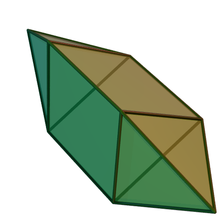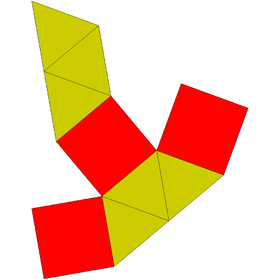| Elongated triangular bipyramid | |
|---|---|
 | |
| Type | Johnson J13 – J14 – J15 |
| Faces | 6 triangles 3 squares |
| Edges | 15 |
| Vertices | 8 |
| Vertex configuration | 2(3) 6(3.4) |
| Symmetry group | D3h, , (*322) |
| Rotation group | D3, , (322) |
| Dual polyhedron | Triangular bifrustum |
| Properties | convex |
| Net | |
 | |
In geometry, the elongated triangular bipyramid (or dipyramid) or triakis triangular prism a polyhedron constructed from a triangular prism by attaching two tetrahedrons to its bases. It is an example of Johnson solid.
Construction
The elongated triangular bipyramid is constructed from a triangular prism by attaching two tetrahedrons onto its bases, a process known as the elongation. These tetrahedrons cover the triangular faces so that the resulting polyhedron has nine faces (six of them are equilateral triangles and three of them are squares), fifteen edges, and eight vertices. A convex polyhedron in which all of the faces are regular polygons is the Johnson solid. The elongated bipyramid is one of them, enumerated as the fourteenth Johnson solid .
Properties

The surface area of an elongated triangular bipyramid is the sum of all polygonal face's area: six equilateral triangles and three squares. The volume of an elongated triangular bipyramid can be ascertained by slicing it off into two tetrahedrons and a regular triangular prism and then adding their volume. The height of an elongated triangular bipyramid is the sum of two tetrahedrons and a regular triangular prism' height. Therefore, given the edge length , its surface area and volume is formulated as:
It has the same three-dimensional symmetry group as the triangular prism, the dihedral group of order twelve. The dihedral angle of an elongated triangular bipyramid can be calculated by adding the angle of the tetrahedron and the triangular prism:
- the dihedral angle of a tetrahedron between two adjacent triangular faces is ;
- the dihedral angle of the triangular prism between the square to its bases is , and the dihedral angle between square-to-triangle, on the edge where tetrahedron and triangular prism are attached, is ;
- the dihedral angle of the triangular prism between two adjacent square faces is the internal angle of an equilateral triangle .
Appearances
The nirrosula, an African musical instrument woven out of strips of plant leaves, is made in the form of a series of elongated bipyramids with non-equilateral triangles as the faces of their end caps.
References
- Rajwade, A. R. (2001), Convex Polyhedra with Regularity Conditions and Hilbert's Third Problem, Texts and Readings in Mathematics, Hindustan Book Agency, p. 84–89, doi:10.1007/978-93-86279-06-4, ISBN 978-93-86279-06-4.
- ^ Berman, Martin (1971), "Regular-faced convex polyhedra", Journal of the Franklin Institute, 291 (5): 329–352, doi:10.1016/0016-0032(71)90071-8, MR 0290245.
- Uehara, Ryuhei (2020), Introduction to Computational Origami: The World of New Computational Geometry, Springer, p. 62, doi:10.1007/978-981-15-4470-5, ISBN 978-981-15-4470-5, S2CID 220150682.
- Sapiña, R., "Area and volume of the Johnson solid ", Problemas y Ecuaciones (in Spanish), ISSN 2659-9899, retrieved 2020-09-09.
- Johnson, Norman W. (1966), "Convex polyhedra with regular faces", Canadian Journal of Mathematics, 18: 169–200, doi:10.4153/cjm-1966-021-8, MR 0185507, S2CID 122006114, Zbl 0132.14603.
- Gerdes, Paulus (2009), "Exploration of technologies, emerging from African cultural practices, in mathematics (teacher) education", ZDM Mathematics Education, 42 (1): 11–17, doi:10.1007/s11858-009-0208-2, S2CID 122791717.
 .
.
 is the sum of all polygonal face's area: six equilateral triangles and three squares. The volume of an elongated triangular bipyramid
is the sum of all polygonal face's area: six equilateral triangles and three squares. The volume of an elongated triangular bipyramid  can be ascertained by slicing it off into two tetrahedrons and a regular triangular prism and then adding their volume. The height of an elongated triangular bipyramid
can be ascertained by slicing it off into two tetrahedrons and a regular triangular prism and then adding their volume. The height of an elongated triangular bipyramid  is the sum of two tetrahedrons and a regular triangular prism' height. Therefore, given the edge length
is the sum of two tetrahedrons and a regular triangular prism' height. Therefore, given the edge length  , its surface area and volume is formulated as:
, its surface area and volume is formulated as:

 of order twelve. The
of order twelve. The  ;
; , and the dihedral angle between square-to-triangle, on the edge where tetrahedron and triangular prism are attached, is
, and the dihedral angle between square-to-triangle, on the edge where tetrahedron and triangular prism are attached, is  ;
; .
. "
"